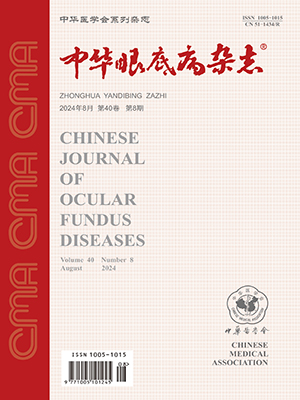| 1. |
Laude A, Cackett PD, Vithana EN, et al. Polypoidal choroidal vasculopathy and neovascular age-related macular degeneration: same or different disease?[J]. Prog Retin Eye Res,2010,29:19-29.
|
| 2. |
Yannuzzi LA, Sorenson J, Spaide RF, et al. Idiopathic polypoidal choroidal vasculopathy (IPCV)[J]. Retina,1990,10:1-8.
|
| 3. |
Bessho H, Honda S, Kondo N, et al. The association of age-related maculopathy susceptibility 2 polymorphisms with phenotype in typical neovascular age-related macular degeneration and polypoidal choroidal vasculopathy[J]. Mol Vis,2011,17:977-982.
|
| 4. |
Cheng Y, Huang L, Li X, et al. Genetic and functional dissection of ARMS2 in age-related macular degeneration and polypoidal choroidal vasculopathy[J/OL]. PLoS One,2013,8:E53665[2014-01-31]. http://www.plosone.org/article/info%3Adoi%2F10.1371%2Fjournal.pone.0053665.
|
| 5. |
Fuse N, Mengkegale M, Miyazawa A, et al. Polymorphisms in ARMS2(LOC387715) and LOXL1 genes in the Japanese with age-related macular degeneration[J]. Am J Ophthalmol,2011,151:550-556.
|
| 6. |
Goto A, Akahori M, Okamoto H, et al. Genetic analysis of typical wet-type age-related macular degeneration and polypoidal choroidal vasculopathy in Japanese population[J]. J Ocul Biol Dis Infor,2009,2:164-175.
|
| 7. |
Hayashi H, Yamashiro K, Gotoh N, et al. CFH and ARMS2 variations in age-related macular degeneration, polypoidal choroidal vasculopathy, and retinal angiomatous proliferation[J]. Invest Ophthalmol Vis Sci,2010,51:5914-5919.
|
| 8. |
Kondo N, Honda S, Ishibashi K, et al. LOC387715/HTRA1 variants in polypoidal choroidal vasculopathy and age-related macular degeneration in a Japanese population[J]. Am J Ophthalmol,2007,144:608-612.
|
| 9. |
Liang XY, Lai TY, Liu DT, et al. Differentiation of exudative age-related macular degeneration and polypoidal choroidal vasculopathy in the ARMS2/HTRA1 locus[J]. Invest Ophthalmol Vis Sci,2012,53:3175-3182.
|
| 10. |
Lima LH, Schubert C, Ferrara DC, et al. Three major loci involved in age-related macular degeneration are also associated with polypoidal choroidal vasculopathy[J]. Ophthalmology,2010,117:1567-1570.
|
| 11. |
Chen H, Liu K, Chen LJ, et al. Genetic associations in polypoidal choroidal vasculopathy: a systematic review and meta-analysis[J]. Mol Vis,2012,18:816-829.
|
| 12. |
Jiang JJ, Wu X, Zhou P, et al. Meta-analysis of the relationship between the LOC387715/ARMS2 polymorphism and polypoidal choroidal vasculopathy[J]. Genet Mol Res,2012,11:4256-4267.
|
| 13. |
Yuan D, Yuan D, Yuan S, et al. The age-related maculopathy susceptibility 2 polymorphism and polypoidal choroidal vasculopathy in Asian populations: a meta-analysis[J]. Ophthalmology,2013,120:2051-2057.
|
| 14. |
Wells GA, Shea B, O’Connell D, et al. The Newcastle-Ottawa Scale (NOS) for assessing the quality of nonrandomised studies in meta-analyses[EB/OL].[2014-01-31].http://www.ohri.ca/programs/clinical_epidemiology/oxford.asp.
|
| 15. |
Lee KY, Vithana EN, Mathur R, et al. Association analysis of CFH, C2, BF, and HTRA1 gene polymorphisms in Chinese patients with polypoidal choroidal vasculopathy[J]. Invest Ophthalmol Vis Sci,2008,49:2613-2619.
|
| 16. |
Sakurada Y, Kubota T, Mabuchi F, et al. Association of LOC387715 A69S with vitreous hemorrhage in polypoidal choroidal vasculopathy[J]. Am J Ophthalmol,2008,145:1058-1062.
|
| 17. |
Park DH, Kim IT. Association of ARMS2/HTRA1 variants with polypoidal choroidal vasculopathy phenotype in a Korean population[J]. Jpn J Ophthalmol,2012,56:60-67.
|
| 18. |
Tanaka K, Nakayama T, Mori R, et al. Associations of complement factor H (CFH) and age-related maculopathy susceptibility 2(ARMS2) genotypes with subtypes of polypoidal choroidal vasculopathy[J]. Invest Ophthalmol Vis Sci,2011,52:7441-7444.
|
| 19. |
Chantaren P, Ruamviboonsuk P, Ponglikitmongkol M, et al. Major single nucleotide polymorphisms in polypoidal choroidal vasculopathy: a comparative analysis between Thai and other Asian populations[J]. Clin Ophthalmol,2012,6:465-471.
|
| 20. |
Miki A, Honda S, Kondo N, et al. The association of age-related maculopathy susceptibility 2(ARMS2) and complement factor H (CFH) variants with two angiographic subtypes of polypoidal choroidal vasculopathy[J]. Ophthalmic Genet,2013,34:146-150.
|
| 21. |
Rivera A, Fisher SA, Fritsche LG, et al. Hypothetical LOC387715 is a second major susceptibility gene for age-related macular degeneration, contributing independently of complement factor H to disease risk[J]. Hum Mol Genet,2005,14:3227-3236.
|
| 22. |
刘冉,李加青,曾婧,等.渗出型老年性黄斑变性与息肉样脉络膜血管病变患者年龄、性别及发病眼别的比较[J].中华眼底病杂志,2012,28:445-448.
|
| 23. |
Ciardella AP, Donsoff IM, Yannuzzi LA. Polypoidal choroidal vasculopathy[J]. Ophthalmol Clin North Am,2002,15:537-554.
|
| 24. |
Gomi F, Ohji M, Sayanagi K, et al. One-year outcomes of photodynamic therapy in age-related macular degeneration and polypoidal choroidal vasculopathy in Japanese patients[J]. Ophthalmology,2008,115:141-146.
|
| 25. |
Honda S, Imai H, Yamashiro K, et al. Comparative assessment of photodynamic therapy for typical age-related macular degeneration and polypoidal choroidal vasculopathy: a multicenter study in Hyogo prefecture, Japan[J]. Ophthalmologica,2009,223:333-338.
|
| 26. |
Hatz K, Prünte C. Polypoidal choroidal vasculopathy in Caucasian patients with presumed neovascular age-related macular degeneration and poor ranibizumab response[J]. Br J Ophthalmol, 2014,98:188-194.
|
| 27. |
Matsumiya W, Honda S, Kusuhara S, et al. Effectiveness of intravitreal ranibizumab in exudative age-related macular degeneration (AMD): comparison between typical neovascular AMD and polypoidal choroidal vasculopathy over a 1 year follow-up[J/OL]. BMC Ophthalmol,2013,13:10[2014-01-31]. http://www.biomedcentral.com/1471-2415/13/10.
|




